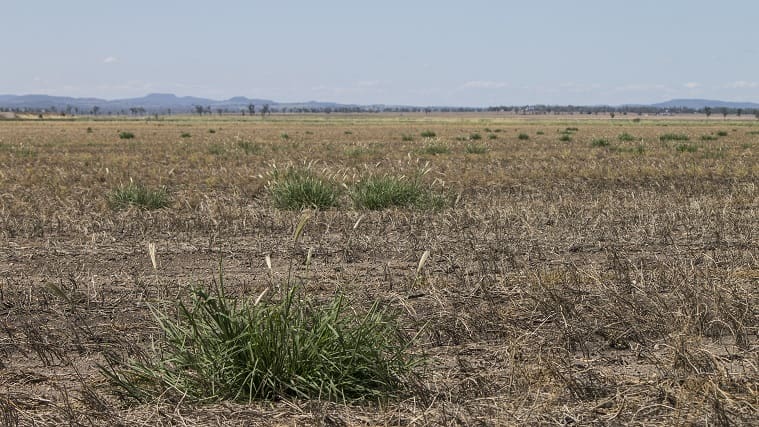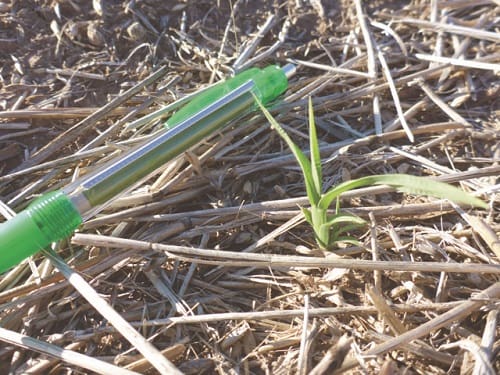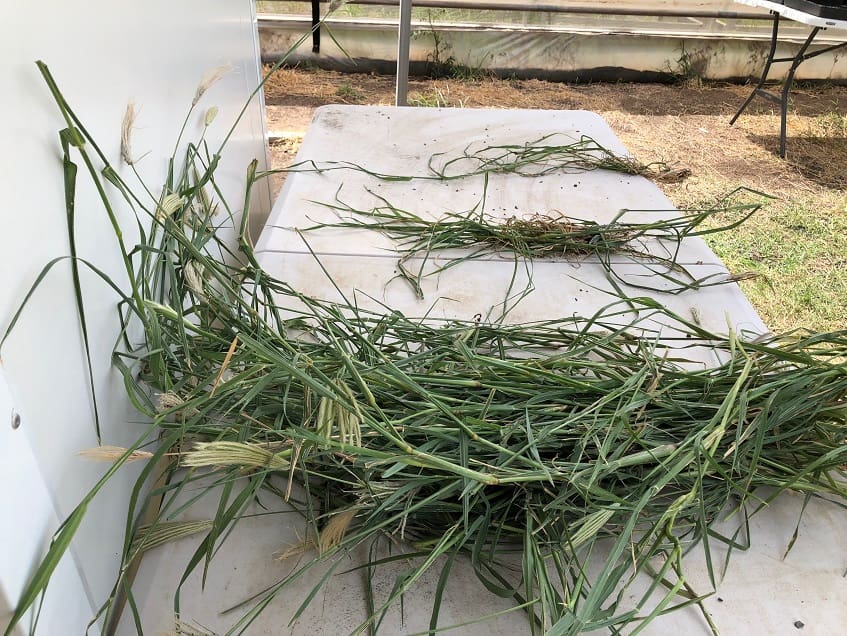
Feathertop Rhodes grass in clumps on fallow country.
FEATHERTOP Rhodes (FTR) grass is quickly becoming one of the biggest weed threats in Australian farming systems, demanding swift and decisive action.
The vast number of seeds produced per plant and the species’ ability to germinate and establish on very small rainfall events, gives this weed a real competitive advantage, particularly in a fallow situation.
In the northern cropping region researchers have observed FTR grass (Chloris virgata) germinating almost all year round, at temperatures ranging from 15/5° to 35/25°C (day/night temperatures).
While many seedlings that establish in winter are killed by frost, some will survive and it only takes a few plants to produce a large number of viable seeds for the next generation.
Recent research by Queensland Alliance for Agriculture and Food Innovation (QAAFI) weed researcher Dr Bhagirath Chauhan has demonstrated that some populations of FTR are producing seed that is capable of germinating just two weeks after they mature.
“Night temperature does affect seed production of feathertop Rhodes grass so it is important to concentrate efforts on preventing germination or controlling these weed populations in spring and early summer,” Dr Chauhan said.
“These early germinated populations are also more able to compete with summer crops and then set seed in-crop.”

Feathertop Rhodes grass is a serious weed challenging no-till farming in Australia. Herbicide is largely ineffective on FTR grass unless it is applied to small, actively growing seedlings.
Being able to tolerate both knockdown and residual (pre-emergent) herbicides, FTR grass can quickly gain a foothold in no-till farming systems.
No-till and stubble retention also provides a favourable environment for germination, establishment and survival of FTR grass because of the moist soil conditions around the weed seed.
An integrated approach, like the WeedSmart Big 6, is needed to tackle this serious weed before it forces a return to full cultivation for weed control:
- Diverse crop rotations – FTR grass is a year-round weed. Having diverse and competitive crops in rotation reduces the risk of a blow-out situation.
- Mix and rotate herbicide MOA – FTR grass is not reliably controlled with a single post-emergent herbicide application. To be effective, the weeds must be sprayed when they are very young and not stressed. At this stage, high rates of glyphosate with the best surfactants available, along with some group A products, can reduce the population. Residual herbicides like metolachlor applied in late winter fallows are very useful in moist soil conditions.
- Double knock glyphosate – Plan to follow any glyphosate application with a double knock to reduce the number of FTR grass survivors.
- Grow competitive crops – FTR grass is sensitive to crop competition. All efforts to increase crop competition through crop and variety choice, narrower rows and stubble management will suppress FTR grass germination. Early weed control in sorghum can effectively suppress weed seed production of FTR grass plants that germinate later in the crop. A competitive cover crop could be a valuable option.
- Stop weed seed set – This is the single-most effective tool to prevent an FTR grass incursion. FTR grass is a prolific seed producer and can quickly get out of hand. Initial invasions often occur as a few ‘mother’ plants forming a weedy patch. Removing large FTR grass plants before they seed, using patch cultivation, chipping, hand pulling or fire, is the best option. Seed is easily spread in overland flow and on vehicles, machinery (particularly headers), people and animals. Extreme care is required when managing weedy patches to avoid spreading the problem.
- Harvest weed seed control – FTR grass could be a good candidate for weed seed collection and destruction at harvest. One study has shown that as much as 93 per cent of the weed seed was retained (held) on the plant at the time of mungbean harvest (Chauhan et al., unpublished data). Increased crop competition tends to encourage taller FTR grass plants, making it easier to capture the seedheads at harvest.

Feathertop Rhodes grass is susceptible to crop competition. Front – FTR from fallow; Middle – FTR from 1m row sorghum; Back – FTR from 0.5m row sorghum.
“We also found that FTR grass seed on the soil surface is not viable after 12 months. Burying the seed lengthens the period that the seed remains viable, so unless the seedbank is completely buried to a depth of 5 cm or more and left undisturbed for more than 18 months, cultivation on its own might not be a good control tactic,” Dr Chauhan said.
“If FTR grass seed is left on the surface, and no more seed is allowed to set, the seed bank will deplete in 12 months. In dry years the seed is likely to persist longer and some seed can be buried at planting or simply falling down cracks in the soil.”
Feathertop Rhodes grass is already widespread across Australia and it is easily transported to new areas during floods, on machinery and in hay.
Roadsides, water channels, head ditches, and on-farm tracks are all sources of weed seed, which can then easily enter cropping areas.
If hay is brought in, it is wise to feed out in defined areas so any FTR grass plants can be more readily seen and removed before they set seed. It is also important for agronomists, researchers and contractors to strictly follow biosecurity practices and ‘Come Clean, Go Clean’.
Source: WeedSmart
For more information about feathertop Rhodes grass control visit the WeedSmart website: www.weedsmart.org.au
Grain Central: Get our free daily cropping news straight to your inbox – Click here

It would appear a long fallow with cultivation would eliminate this weed, unlike the plague of Johnson Grass on the Darling Downs. Unfortunately Johnson Grass is immune to all chemical treatment and is spread by cultivation (due to rhizomes). Any animal or machine that comes in contact with it’s seed or rhizomes, water run-off and wind are all spreaders. As usual, councils are largely responsible for the spread along roads and drains and the next 20 years will see most of the D/Downs cropping land rendered unfit for cropping. As it is also toxic to stock at times, grazing it is a risky business. The image at the top of this post looks like most paddocks on the Downs, except the weed patches shown would be Johnson’s. Within the next 10 years, all of those patches will have joined together. Would it be possible for FTR to out grow Johnson’s in a controlled situation with slashing and spraying? How resistant to Glyphosate is FTR? I would love to hear anyone’s experiences with this. Thanks.